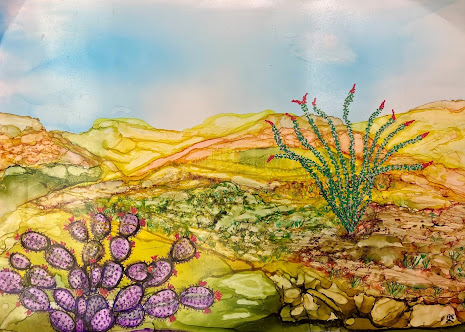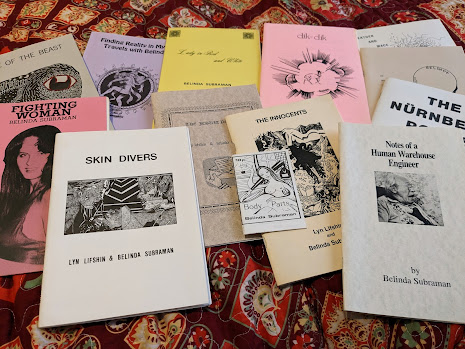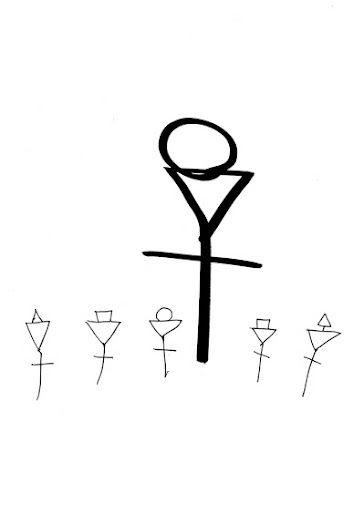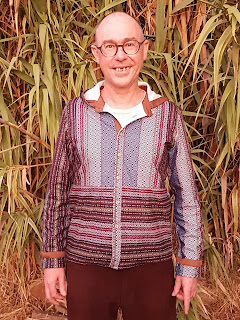GAS: What life event drew you into poetry?
BELINDA: I was dyslexic and had a hard time learning to read. I finally learned to put my finger under the letters and pronounce each one. Even today I hear myself read each word inside my head. It was in the 6th grade that I became excited by poetry. I don’t remember what prompted me to read books of poetry. Maybe it was my teacher, Mrs. Woodruff. I remember writing poems in the 7th grade. They were often humorous and classmates enjoyed them and passed them around. I can say poetry has been an important part of my life since around eleven years old.
GAS: Are you a musician?
BELINDA: I don’t think so but I can make some cool sounds on steel tongue drums and I took African drumming lessens for years. Sample:
GAS: Regarding the visual arts, are you taught or self taught?
BELINDA: Self taught, but I read books, see videos, go to museums, etc. All those things tigger excitement to try new things. Only recently do I feel like I’m finding my own voice.
GAS: How is the place you live reflected in your creative work?
BELINDA: I live in the desert. Cacti seems to pop up in a lot of my paintings and I grew up playing in a forest so trees often appear. However, mostly I paint abstracts. As for poetry (and art), everything thing I’ve experienced plays into it as well as the places I’ve lived. One time I wrote down all the places I’ve lived and it came to about 25. I’ve lived in a lot of states, lived in Germany for six years and traveled to many countries.
GAS: How did GAS: Poetry Art and Music come about?
BELINDA: I’ll try to make a long story short. I started appearing in small magazines under different names in the 70s (Belinda Bumgarner, Mary Eldreth, Belinda Subramanian).
I started a magazine in 1984 called Gypsy, mostly because we were moving every couple of years or so. 1994 was the last regular publication of Gypsy and Vergin' Press for a long while. In the early 2000s I did one more print issue called Loose Leaf Gypsy. It had hand-colored drawings, poems and photos on 100 lb. paper. The poetry was bound in the middle of a folder and the side pockets held art that you could frame. That was way too expensive so the next Gypsy was online. I did three issues online back when personal computers were still fairly new. I didn’t know how to code and used a Flash program that not everyone could see. Somewhere in all this time I went through a divorce, went to nursing school and became a hospice nurse (as well as producing a weekly interview show and being politically active). Around 2007 I did a blog called Gypsy Art Show and did articles about poetry, art and music. A couple of people contributed reviews and essays from time to time. After a few years I bought the domain name but when it came time to renew the name I could never do it. There was no way. I kept going in circles. I lost the blog and “they” tried to sell my name back to me for $5,000. Heck with that. In 2020 I started GAS: Poetry, Art and Music which you are reading right now. I also started a video component to GAS which you can click on from this site. Example:
GAS: Are you able to discuss the concept of ”success” in the arts?
BELINDA: That would be different for each artist. I have created things all my life but only recently was able to call myself an artist. I only started showing my paintings on the internet about 4 years ago. The first one I showed several people asked if it was for sale. I was amazed and stunned and just said I’d never thought about it. But I gave a price and someone came to pick it up. I continued to post new paintings and requests to buy came in nearly every time. It took awhile to part with more paintings and to figure out what they were worth, or rather what price it would take for me to part with them. Somewhere around this time I started considering myself an artist. I always thought of an artist as a sort of magician and finally decided I was making magic too.
GAS: Do you find more inspiration, re:subject matter, from outside or inside yourself?
I don’t think I can make a distinction like that because everything we witness goes through our own filters and forms our unique interpretations based on our knowledge and experience or lack of them. I guess the answer is both. I do tend to be more philosophical now so sometimes my writing is more about ideas but that came from a lifetime of synthesizing experiences.




















